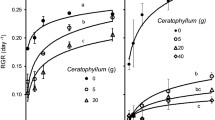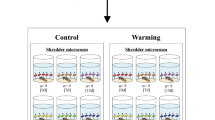Abstract
The kelp Laminaria saccharina dominates soft bottoms in 4–10 m depth in Kiel Bay. Experimental sporophytes transplanted to 2 and 5 m depth showed the typical annual growth pattern of Laminaria species. Surprisingly, 2 m plants died after the first resting phase, whereas 5 m plants survived and showed outgrowth of a new blade generation. Thalli at both depths were infected with the brown algal endophyte Streblonema aecidioides, with host deformations being significantly stronger in 2 m plants. Growth rates of infected sporophytes were reduced. Exclusion of UV light in 2 m depth resulted in less infected thalli. Discs excised from L. saccharina and cultivated in different photon fluence rates from 10–600 µmol m−2 s−1 did not differ in growth rate, photosynthesis or dark respiration. Hence, an exclusion of L. saccharina from shallow depths caused by high light cannot be concluded. We suggest the biological interaction with the endophyte S. aecidioides, amplified by UV light, to be most important for the exclusion of L. saccharina from shallow depths in the western Baltic.
Similar content being viewed by others
References
Chapman, A. R. O., 1973. A critique of prevailing attitudes towards the control of seaweed zonation on the sea shore. Bot. mar. 16: 80–82.
Chapman, A. R. O., 1995. Functional ecology of fucoid algae: twenty-three years of progress. Phycologia 34: 1–32.
Cullen, J. J., P. J. Neale & M. P. Lesser, 1992. Biological weighting function for the inhibition of phytoplankton photosynthesis by ultraviolet radiation. Science 258: 646–650.
Drew, E. A., 1974. Light inhibition of photosynthesis in macroalgae. Br. J. Phycol. 9: 217–218.
Drew, E. A., 1983. Physiology of Laminaria I. Use of excised lamina discs in short and long term experiments. P. S. Z. N. I: Marine Ecology 4: 211–226.
Drew, E. A. & W. A. A. Robertson, 1974. A simple field version of the Winkler determination of dissolved oxygen. New Phytol. 73: 793–796.
Fortes, M. D. & K. Lüning, 1980. Growth rates of North Sea macroalgae in relation to temperature, irradiance and photoperiod. Helgoländer Meeresunters. 34: 15–29.
Friedländer, M. & A. Ben-Amotz, 1991. The effect of outdoor culture conditions on growth and and epiphytes of Gracilaria conferta. Aquat. Bot. 39: 315–333.
Hatcher, B. G., 1977. An apparatus for measuring photosynthesis and respiration of intact large marine algae and comparison of results with those from experiments with tissue segments. Mar. Biol. 43: 381–385.
Huppertz, K., D. Hanelt & W. Nultsch, 1990. Photoinhibition of photosynthesis in the marine brown alga Fucus serratus as studied in field experiments. Mar. Ecol. Prog. Ser. 66: 175–182.
Kain, J. M., 1975. Algal recolonization of some cleared areas. J. Ecol. 63: 739–765.
Kain, J. M. 1979. A view of the genus Laminaria. Oceanogr. mar. Biol. ann. Rev. 17: 101–161.
King, R. J. & W. Schramm, 1976. Photosynthetic rates of benthic marine algae in relation to light intensity and seasonal variations. Mar. Biol. 37: 215–222.
Larkum, A. W. D. & W. F. Wood, 1993. The effect of UV-B radiation on photosynthesis and respiration of phytoplankton, benthic macroalgae and seagrasses. Photosynth. Res. 36: 17–23.
Lüning, K., 1979. Growth strategies of three Laminaria species (Phaeophyceae) inhabiting different depth zones in the sublittoral region of Helgoland (North Sea). Mar. Ecol. Prog. Ser. 1: 195–207.
Lüning, K., 1981. Light. In C. S. Lobban & M. J. Wynne (eds), The biology of seaweeds. Blackwell, Oxford: 326–355.
Markager, S. & K. Sand-Jensen, 1992. Light requirements and depth zonation of marine macroalgae. Mar. Ecol. Prog. Ser. 88: 83–92.
Peters, A. F. & B. Schaffelke, 1996. Streblonema infection in the kelp Laminaria saccharina (L.) Lamour. in the western Baltic. Hydrobiologia 326/327: 111–116.
Starr, R. & J. A. Zeikus, 1987. UTEX- The culture collection of algae at the University of Texas at Austin. J. Phycol. 23: suppl. 1–47.
Wood, W. F., 1987. Effect of ultra-violet radiation on the kelp Ecklonia radiata. Mar. Biol. 96: 143–150.
Author information
Authors and Affiliations
Corresponding author
Rights and permissions
About this article
Cite this article
Schaffelke, B., Peters, A.F. & Reusch, T.B.H. Factors influencing depth distribution of soft bottom inhabiting Laminaria saccharina (L.) Lamour. in Kiel Bay, Western Baltic. Hydrobiologia 326, 117–123 (1996). https://doi.org/10.1007/BF00047796
Issue Date:
DOI: https://doi.org/10.1007/BF00047796




